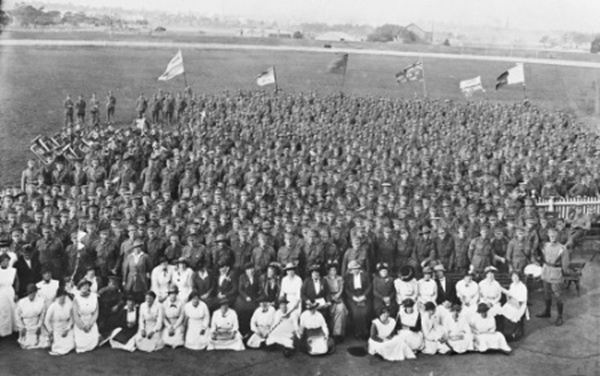Charmichael’s 1000 – Their Triumphs and their Trials
Carmichael’s 1000 – Their Triumphs and their Trials
Left Pic: 36bn before leaving Newcastle. (PHOTO: CONTRIBUTED)
SIXTY-SIX men from the Coffs Coast marched off to WWI as part of Carmichael’s 1000.
Only 45 returned.
They were farmers, labourers, mill workers, miners, carpenters, butchers, blacksmiths, engineers, slaughtermen, hairdressers, auctioneers, engine drivers, storekeepers, oystermen, cabinet makers, wheel wrights, bank clerks, tailors, farm hands, chemists, dairymen, carriers, fitters, cashiers, mercers, ironmongers and even a chair caner.
The list of occupations of the men who left homes from Woolgoolga to Macksville to join what became the 36th battalion AIF is not only a snapshot of society in Coffs Harbour and its surrounds in 1915 but an indication of the gaps in everyday life that their departure must have left behind.
The history of Carmichael’s 1000 and the 36th Battalion AIF has been written by Manning Valley author and researcher Margaret Clark, who will speak about her new book at a special 2015 Heritage Festival event in Sydney on April 14.
The free evening event will be held at Leichhardt Library.
Mrs Clark’s first book, Postcards from the Front – Still Going Strong was based on 200 postcards written by one of the soldiers of the 36th, Alf Haynes, who did survive the conflict and returned home in 1919.
“Many of the men joined as a result of the march, entitled North Coast Marchers, that set off from Grafton picking up volunteers, including many from the Coffs area, as it moved south along the coast to Newcastle,” Mrs Clark said.
“Using a mix of photographs, letters and postcards, in addition to the official war diaries of the unit, I have created their story.
“The men served in some of the most horrendous battles of the war, including Messines Ridge, Passchendaele and the battle for Villers Bretonneux.
“Due to their massive losses this battalion was disbanded at the end of April 1918 with the remaining men spread throughout the other battalions in the brigade.
“A memorial to the men from the area is located in a church at Coffs Harbour.
“The letters and journals that they wrote reflect their determination to win and their belief that they were fighting for a worthy cause.
“They also give a picture of the horrors of warfare.
Mrs Clark said after discovering no history of the battalion had ever been written, she contacted the Army History Unit and was awarded a grant to compile a record of the battalion’s exploits, a task which took her three years.
She said she had told the story through the letters, journals and postcards that the men sent home, many made available by the Australian War Museum and “many wonderful contributions” by descendants of the soldiers.
She said it was hard not to become involved in the men’s stories and it could be heart-rending to turn a page of a journal to discover no more entries as the soldier had been killed.
“I hope the publication will keep alive the memory of these men who fought for their families, their country and their King,” Mrs Clark said.
“I believe that a substantial number of families in this area will find this book of interest.”
The 36th was granted the title Carmichael’s 1000 as it was largely due to the efforts of Ambrose Carmichael that the battalion was formed.
Carmichael was a NSW parliamentarian who decided to form a riflemen’s battalion from among the members of rifle clubs throughout the state.
He was largely successful and enlisted himself with his battalion, rising to the rank of captain and winning the Military Cross for his bravery and his ability to inspire his men.
Carmichael’s 1000 – Their Triumphs and their Trials, is published by War Books Publishers.
Story by Belinda Scott – Coffs Coast Advocate









